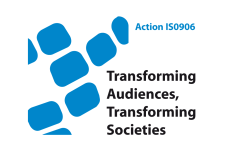- About the Action
- Events
- PhD workshop - Ljubljana 2014
- Action Open Conference - Ljubljana 2014
- New Media and Participation conference - Istanbul 2013
- Belgrade meeting 2013
- Media literacy research and policy - Brussels 2013
- ICA Pre-Conference 2013
- Tampere meeting 2013
- Budapest workshop 2012
- Milan meeting 2012
- Brussels PhD workshop 2012
- Brussels Action workshop 2012
- London meeting 2011
- Zagreb Conference 2011
- Lisbon meeting 2010
- Affiliated events
- WG 1
- WG 2
- WG 3
- WG 4
- Cross-WG
- Output
A critical analysis of two audience prototypes and their participatory dimensions
Radojkovic, M., Milojevic Ana (2011). A critical analysis of two audience prototypes and their participatory dimensions. CM Communication Management Quarterly, 6(21), 181-202.
Abstract: This article discusses how the concept of audience theory has been developed within two basic intellectual traditions, resulting in two basic prototypes. On one side, there is the trajectory of the “mass audience” that was created and developed parallel with the emergence of the media of mass communication. The mass audience is regarded as a multi-layer collectivity, residing at the end of a successive linear communication process – sender, channel, message, receiver and effects. In this one-way communication model, the audience is primarily the receiving structure, with little or no opportunity for feedback and participation in the communication process. The other prototype is linked to the development of new digital media and the internet; here the public is theoretically considered as “cross media” and active. The audience of new media is seen as a heterogeneous and structural collective in the communication model that characterizes the flow of information “many to many”. This prototype attributes to the new, active audiences or users unlimited power to participate and shape the communication processes. We discuss features of the two prototypes, including media usage, media access, information resources, time engagement and functions derived from media use. The most important feature we take up, however, is participation. We point out the problems and limitations of both prototypes in this regard. On the one hand the study of audiences has long been rooted in the concept of mass audience and limited with its primal orientation towards the effects of mass communication, while on the other hand, the emerging prototype 2 is all too easily granted participatory capacities, especially concerning the public sphere. Therefore, the theorists of new and old media must step outside the prevailing postulates and consider the audience beyond the two prevailing prototypes in order to further deepen our knowledge and understanding of contemporary audiences and their participation.

